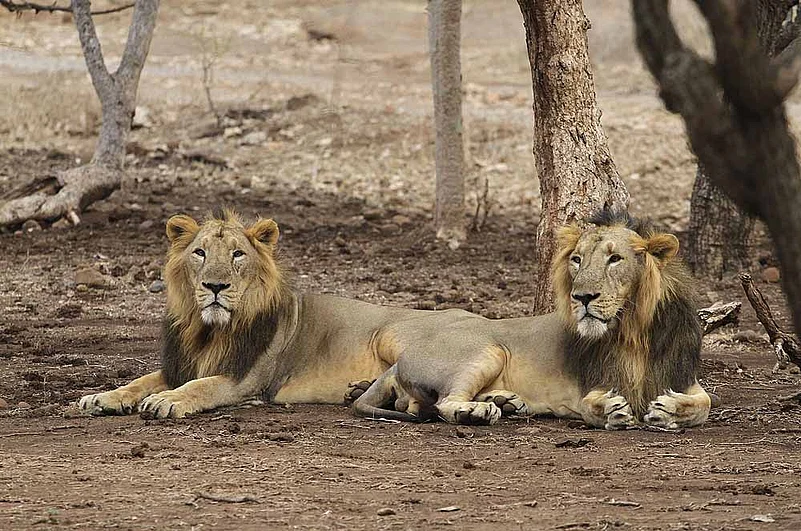“During the grand period of shikar of Maharaja Ram Singh (1835-1880) when human population was low, extensive wastelands were teeming with black bucks and chinkara. (Yet cheetahs) used to be imported from Afghanistan and Africa—it would be sufficient to conclude here that the hunting cheetah never existed in the wild in Rajasthan.”
That was not the authors of the thought-provoking Exotic Aliens, but two of India’s wildlife experts, Kailash Sankhala and V.D. Sharma, way back in 1981, for the IUCN’s Cat Specialist Group.
This well-researched and well-argued book questions the conventional belief about two animals that are always, automatically, thought to be Indian in origin—the lion and the cheetah. The authors say they might have been little more than exotic aliens, brought in by ship from Africa, or via the old overland trade routes on the west. When I first heard about this, I too reacted with predictable disbelief. But after reading and re-reading Exotic Aliens, I came to believe that the opposite might just be true.
As for lions, the very symbol of today’s India, the Ashoka pillar, seemed to intuitively suggest they existed in Ashoka’s third century BC reign, when they symbolised the Mauryan king’s ‘supremacy and authority’. But take another look at the Ashoka pillar. Those lions look nothing like the ones we see in Gir today. Their manes are not just thicker like those of Assyrian lions, but they were manicured such that they hung only to their knees. Clearly, these were tame lions. So where lies the truth?
In Wild Animals in Central India (1931), A.A. Dunbar Brander opines that there were no lions in central India, and says this of the cheetah: “The hunting leopard Cynalurus jubatus has now almost entirely disappeared from the province without apparent reason, and I only know of three animals having been procured in the last 20 years”. Even these animals, it seems, might have been three trained cheetahs imported from Africa! In Valmik’s words: “Why is it that there are hardly any pictures of lions as hunting trophies and the few that exist tend to have been taken after 1886 in Gir? Where are the cheetahs in the hunters’ bags? As I researched my thesis, I grew convinced that I had stumbled upon the biggest myth perpetrated about these two species in India. Tigers and leopards were everywhere in the historical record, whether written, photographed or depicted in other visual forms, but lions and cheetahs were almost invisible.”
Wildlife issues in India are riddled with politics and diehard wildlifers were predictably aghast to hear people of the stature of Romila Thapar and Yusuf Ansari, a Mughal history specialist, not merely accept but strongly support Valmik Thapar’s ‘heretical’ postulation. However, those who react emotionally to the idea that lions and cheetahs might have been imported should undertake journeys of explorative investigation. Captain Thomas Williamson, author of the epic Oriental Field Sports, for instance, suggested that in the 1780s, “while pig-sticking, one was likely to encounter tigers that had strayed into the open, but never lions, or for that matter, cheetahs”.
The thread of the arguments presented follow pre-Christian, pre-Islamic, Mughal and colonial periods and seem to find support even by modern-day geneticists. Stephen J. O’Brien, in Tears of the Cheetah: The Genetic Secrets of Our Animal Ancestors, confirms that “[the] physical traits in Asian lions are manifestations of extremely severe in-breeding in their very recent past. [But] the evidence for our conclusions was encrypted in their genes...the bottleneck that compromised the Gir lions’ genetic variation dated back not just one century but three millennia!” Romila Thapar adds assuredly: “If there were lions here (in Kutch), why do they not occur on Indus seals, since the area had many Indus cities and settlements?.... It must have been an exotic import all along as there is no gradual decline in the species. I believe that the lion came to India just before or with Alexander’s invasion of India around the third or fourth century.” An examination of seals and pottery from Harappan cities also reveals that lions were simply not depicted, while tigers, bulls and rhinos were, in plenty.
Frankly, I have seldom read a better referenced book on the subject of lions and cheetahs and find myself agreeing with Valmik Thapar that neither lions nor cheetahs were indigenous to India. The book is also a very good read. If you have not got a copy yet, get one. Or get your library to acquire one.
(Sahgal is the editor of Sanctuary Asia)


























